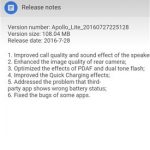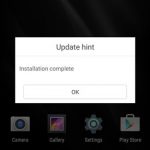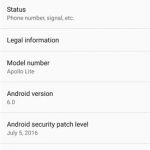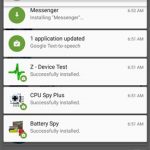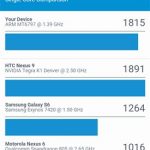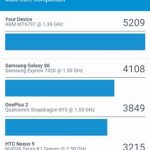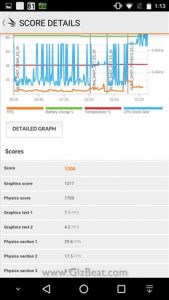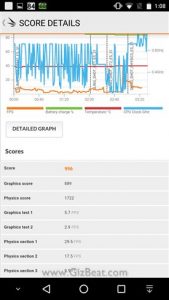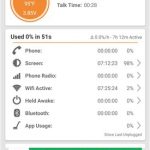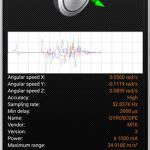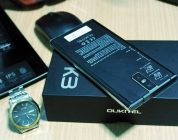Full, real Vernee Apollo Lite review.
Vernee Apollo Lite review Marshmallow OS
Slingshot, an extremely demanding test that will show you where your phone really stands in regards to modern gaming.
The ROM on the Vernee Apollo is Android 6.0 Marshmallow, with the latest ROM as of this review bringing the Android security patch up to July 2016.
- OTA
- OTA successful
- Virtual button options
- Android 6.0
- Play Store downloads
Vernee Apollo OS quick notes
- The system animations and transitions are quick and fluid. No stutters or frame drops.
- App retention is excellent, with apps even 20 apps back sitting right where you left them.
- Switching between apps in memory is instantaneous.
- Apps not already in memory load extremely quickly.
- Android is Vanilla AOSP Android with little change.
- Zero junkware installed.
- Google Play Store working without issue.

Vernee Apollo review RAM
One of the big pulls of the Vernee Apollo is the huge 4GB RAM. To put it simply, this is more than the average user will need, and probably more than a power user will ever use as well.
It means being able to load up several big 3D games, several Chrome tabs, several chat apps, and Facebook, and switch between them without them closing while in the background.
Beyond the goodness of not having your apps close down on you when switching, it also gives the Vernee Apollo a big future proofing.
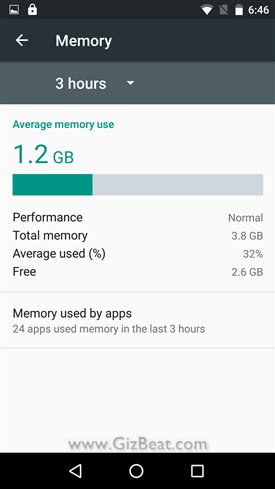
4gb RAM
Vernee Apollo lite Antutu, GPU, gaming, performance
For gamers, the GPU is the most important aspect of a phone. While the popular Helio P10 will satisfactorily run most games, it slows down to below 30fps on some very demanding games at high settings. This isn’t a huge deal, as 24fps is satisfactory for most users, however avid gamers will want the fps to remain at 30fps+
You can be sure Vernee Apollo with MT6797 Helio X20 is up to the task, as it carries the very powerful 4-core ARM Mali-T880MP4 which scores more than double the Helio P10’s GPU.

Vernee Apollo Geekbench
The Vernee Apollo Lite scored 1815 on Geekbench single core and 5209 on Geekbench multi. Take a look at the screenshots to see how Apollo Lite fares against phones such as Galaxy S6.
- Geekbench multi
Vernee Apollo 3DMark Slingshot
3dMark Ice Storm was just too weak of a test. Phone tech caught up too fast and blew the test out of the water. 3dMark decided to take the test to another level with Slingshot, an extremely demanding test that will show you where your phone really stands in regards to modern gaming.
The Vernee Apollo scored 1300 with ES3.0 and 996 with ES3.1. This puts it in the big boy leagues.
- Slingshot ES3.0
- Slingshot ES3.1
Vernee Apollo PCMark
PCMark is a test which checks a phone for everyday productivity such as browsing, watching videos, editing images, and scrolling dense pages of text and pictures. On PCMark Vernee Apollo scored 4523
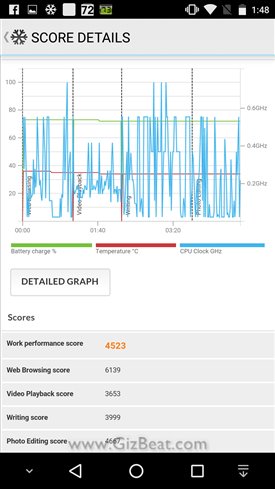
PCMark
Vernee Apollo Antutu
Our Antutu test wasn’t quite as high as what the marketing material from Vernee shows, but we’re also in a relatively hot environment so there may be some minor throttling going on. Whatever the case, 87k isn’t too shabby.
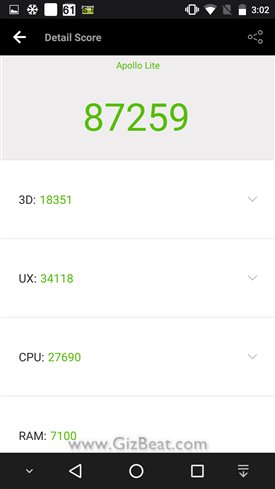
Antutu
Vernee Apollo Lite review battery life
The Vernee Apollo battery lasted a big 7h+ on our battery test.
As with most MediaTek phones we’ve tested, the moment a phone hits 100% is not a full saturation. 100% is to full saturation as 99% is to 100%. That is, there’s an additional “1%” your phone will charge after it hits 100%.

The test is run with a 720p video over YouTube WiFi with the display set at 140lux (about 35-40% brightness on latest ROM).
7 hours on this test means the Vernee Apollo should give a moderate user about 5 hours onscreen through a 12-24 hour period.
Vernee Apollo Lite battery charging
We initially had an issue charging the Apollo, with it only charging at 5V .44A. Investigating further, we found this to be an issue with the USB cable included with the phone.

Switching over to a different cable we found charging to be excellent, pumping the Vernee Apollo from 5% to 40% in about 15-20m, and to full in about an hour. For most of the charge the push was at 9V 1.80A, and slowed down towards the tail end of the charge.
Note the 9V charging happens only with the display off. With the display on it bumps down to 5V, but still charges at a very good rate.
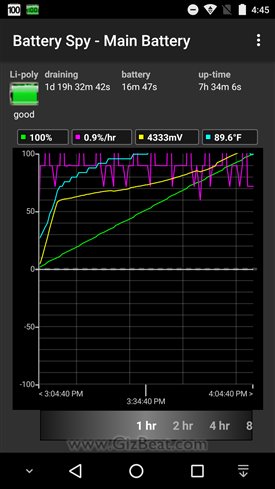
Vernee Apollo Lite fingerprint sensor
The Touch-ID on the Apollo Lite is top notch. The Apollo allows up to 5 fingers to be scanned in. Using just one of the profiles with a single finger, we found response to be excellent, allowing fairly sloppy scan-ins from any angle.

In addition to the great scanning performance, the Apollo allows us to scan in from display off / deep sleep.
Speed is very quick coming into Android from fingerprint unlock, whether it’s from screen off or screen on. Note, that keeping the fingerprint sensor security on can cause battery drainage.

Fingerprint
Vernee Apollo Lite review style and build
Build on the Apollo is great. Very solid, with zero creaks or loose points. The buttons are firm and produce a tactile click when pressed. Running a fingernail with moderate pressure against the rear metal produces no visible scratching.
The Apollo carries a CNC machined metal back piece, with slightly off tone pieces at the top and the bottom of the back, along with a nice piece of trim in between.

We think a more raw brushed metal look would have been great here; as it is, it looks more painted than brushed, though there is some light brush texture to it if looking closely. Regardless, this is personal taste and the Apollo looks very good, with the back piece giving off a classy sheen.
There are no capacitive buttons on the Apollo Lite. Instead the user uses virtual onscreen controls. This is the way Android was meant to be used as evident by Google’s own Nexus line.
Vernee Apollo Lite camera review image samples
One of the pluses of the Apollo is its camera sensor, Samsung S5K3P3. This sensor used in Ulefone Future and Xiaomi Redmi Note 3 Pro.

The 16mp Samsung S5K3P3 is one of the best sensors available in mid-range mobiles. Straight out of the camera, the sensor generally produces very good images beyond adequate for social sharing and even making medium-sized prints.
Images sometimes come out slightly over-saturated, but that seems to be the trend these days. If it’s a bit much, you can reduce saturation in camera settings no problem.

All images in the gallery are unedited other than crop, resize, save at 75% quality. Image #1 is a normal (non-HDR) shot and looks great. Images #4 and #8 are HDR. Image #9 is from the front camera. To see these images at their full resize (1280×720) and compare them against other phones, check out the albums here (opens in new tab).
Vernee Apollo WiFi
WiFi on the Vernee Apollo is great, staying stable and fast 40m/131ft. The Apollo also supports the newer 5GHz standard in addition to 2.4GHz.
Vernee Apollo review GPS
GPS on the Vernee Apollo is great, locking within several seconds and maintaining 30+ on at least 4 satellites at all times.
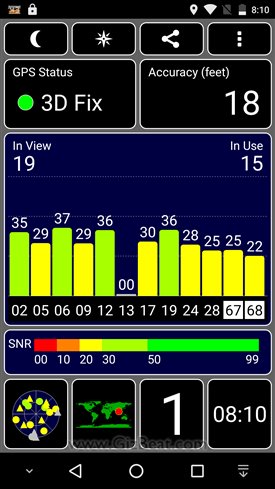
GPS
Vernee Apollo Sharp IGZO display
As mentioned in the preview, the Apollo carries a Sharp IGZO display. It’s a very good display with even brightness across the frame. Viewing angles are excellent, there’s no pixel light bleed at the corners, and the edges are free from evident vignetting (darkening).

Maximum brightness hits 372lux and minimum brightness hits a nice low 15lux.
In the Vernee Apollo Lite OS settings there’s an option to set the display to vivid, or to custom settings, which allow you to make adjustments to temperature, brightness, saturation, and contrast.
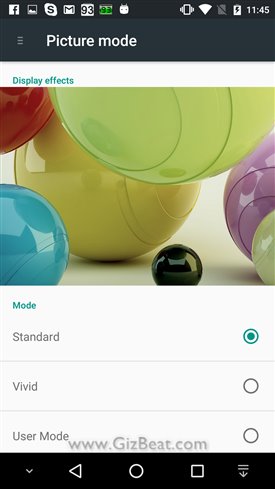
Display options
As opposed to some Helio P10 phones we’ve recently tested, the MTK6797 Vernee Apollo Lite bootloader is unlockable, which means you can temporary boot TWRP or flash ROM partition files through fastboot instead of being forced to flash with SP Flash Tool.
By flashing TWRP, we can then install root through custom recovery. Of course we can also use the old school method and flash via SP Flash tool.
You can see a full guide at GizBeat (opens in new tab)
Vernee Apollo review other components
- Vernee Apollo lite compass: working without issue
- Vernee Apollo lite gyroscope: working without issue
- Vernee Apollo lite OTG: working without issue (tested bluetooth mouse, keyboard, generic gamepad)
- Vernee Apollo lite light sensor: working without issue. Sensing different light levels and appropriately adjusting display brightness
- Vernee Apollo lite FM radio: working without issue
- Vernee Apollo lite notification LED: working without issue. The notification LED is RGB and excellent to see it’s slow pulsing in a pleasing manner
- FM radio
- Compass
- Gyroscope
Vernee Apollo lite conclusion summary
Good battery life, the very good Samsung S5K3P3 camera sensor, very good GPS and WiFi, a compass and gyroscope, Android 6.0, and super fast charging, all come together to make the Vernee Apollo Lite a phone we can recommend.
Ulefone Future review
To seal the deal, the Vernee Apollo also includes the very powerful MTK6797 Helio X20 SoC which pushes even the most demanding 3D games at 30fps, huge 4gb RAM, and big 32gb storage with the option to expand.
Full Vernee Apollo Lite review is coming soon. Subscribe to be notified when the review is complete. For now we’ll go through a review of the Vernee Apollo specifications to see if we can get a glimmer of what to expect.
Vernee Apollo review SoC
The SoC on the Vernee Apollo is MT6797 Helio X20. This is a very strong system and according to Vernee screenshots gives us a huge 95k on Antutu.
Vernee Apollo CPU
The CPU on the Vernee Apollo is part of what makes the Apollo so juicy; all together the Apollo has ten cores, sometimes referred to as deca-core. There are two Cortex-A72 cores are clocked at the maximum 2.3GHz, four Cortex-A53 cores at 1.9GHz, and four Cortex-A53 cores at 1.4GHz. All cores are 64-bit.
big.LITTLE
The way these ten cores work together is by using the powerful A72 cores for heavy processing tasks, while the Cortes-A53 cores handle lesser background tasks and tasks not requiring a large amount of juice.
It all works together to theoretically give maximum battery life, while having heavy-hitting cores ready to kick in so you don’t get slowed down when load gets tough.
Taking a look at the CPU Antutu CPU and UX scores we see it scores 28k/40k. A huge jump compared to the very smooth Helio P10 MT6795 with scores of 16.5k/22.3k respectively. In short, the Vernee Apollo should be butter smooth and handle all tasks thrown at it with ease.
Vernee Apollo Lite GPU
The GPU on the Apollo is ARM Mali-T880MP4. The “4” at the end of the GPU model name indicate the GPU is a 4-core GPU.
In the Helio X20, the Mali-T880 cores are clocked at 780MHz, and on Antutu GPU, the Vernee Apollo scores 17k. To put this in perspective, it’s more than 2x the score of Helio P10, which runs most advanced 3D games at 30fps. In short, it’s beyond what’s needed for gamers.

Now set to make further headway into the market, they’re launching the MT6797 Helio-X20 Vernee Apollo.
- SoC: MTK6797 Helio-X20
- CPU:
- 10-core 64-bit
- 2x Cortex-A72 @ 2.1GHz ~ 2.3GHz
- 4x Cortex-A53 @ 1.85GHz
- 4x Cortex-A53 @ 1.4GHz
- GPU: Mali-T880MP4@780MHz
- Antutu: 94515
- RAM: 4GB
- ROM: 32GB
- Display: 5.5″@1080p Sharp IGZO IPS OGS
- Protection: 2.5D Arc Gorilla Glass 3
- TF SD expandable: Yes (up to 128GB)
- OS: Vanilla Android 6.0 Marshmallow
- Rear camera sensor: 16MP Samsung S5K3P3
- Front camera sensor: 5MP Samsung S5K5P2
- 4K video support: Yes
- Quick charge: Yes (50% charge in 30m)
- Battery: 3180mAh
- Fingerprint sensor: Yes
- USB: Type-C
Vernee Apollo USB Type-C
Charging
The Vernee Apollo carries Type-C quick charging dubbed “Pump Express”. According to Vernee, this will charge the Vernee Apollo up to 50% in a very quick 30 minutes.
Type-C digital music out
One of the more interesting and unique features of the Apollo is that it carries Type-C digital music out, which allows music to be losslessly outputted through the USB port.
For those of us not ready to switch over, the Vernee Apollo Lite does include a standard analog 3.5mm audio out, unlike the Moto Z and most recent LeEco releases which leave us stranded with Type-C audio output only.
Vernee Apollo Lite review display
Specification wise, the Vernee Apollo display is about as good as LCD gets. It’s a Sharp Indium gallium zinc oxide (IGZO) display. Sharp, one of the best display makers in the business have tightly latched onto IGZO technology.
IGZO tech allows displays to be thinner and lighter and can have a dramatic affect on battery performance.
From Sharp: When displaying still images, it achieves power savings of a staggering eighty to ninety percent* by pausing the driving signals to maintain the same image.
Vernee Apollo Lite review components
- G-sensor
- P-Sensor
- L-sensor
- Gyroscope
- Compass
- hall
- Fingerprint
- OTG
- LED notification
- Bluetooth 4.0
- WiFi 2.4GHz/5GHz
Proper for a phone in this price range, the Vernee Apollo Lite includes a compass, gyroscope, dual-band WiFi, and the standard array of components seen on most phones.
Vernee Apollo review RAM ROM
RAM
RAM on the Apollo Lite is an enormous 6gb RAM. Well beyond what’s required for casual users and power users alike. With RAM as big as this, you could easily have several big 3D games running in the background, along with several tabs open in Chrome, several chat apps open and YouTube running without any of them falling out of memory. It means instantaneous multi-tasking and coming back to an app exactly where you left it when switching apps.
To put it further in perspective, even phones with 2gb RAM are able to hold 6-10 normal sized apps in memory without having to close them. 4gb is comparatively huge.
ROM storage
Storage on the Vernee Apollo Lite is a big 32gb. This more than enough for most users, and the Vernee Apollo also gives us the option to add TF SD storage up to 128gb.

Vernee Apollo Lite camera sample images

The Vernee Apollo camera carries the great mid-range sensor, Samsung S5K3P3. This is the same 16mp sensor carried by Xiaomi Redmi Note 3 Pro. It produces images with very good color, sharpness and depth. You can see a sample gallery in the Redmi Note 3 Pro Samsung S5K3P3 gallery (opens in new tab).
If you’re looking for an extremely powerful mobile at a great price point, the Vernee Apollo Lite is one to short list.


